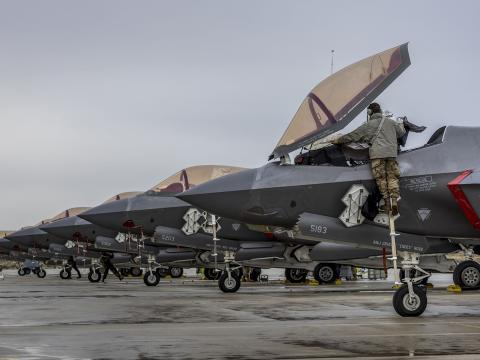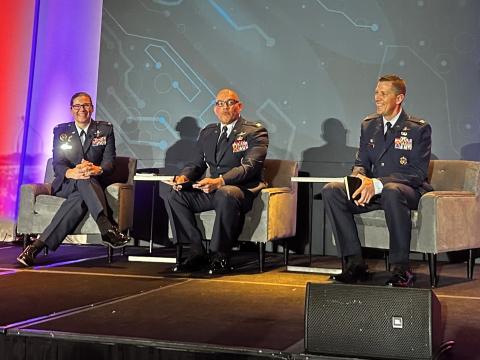Air Force Researchers Set Stratospheric Goals
High technology takes on a literal meaning as exotic programs gain altitude.
Autonomous batwing aircraft, boomerang-shaped surveillance vehicles, hypersonic exoatmospheric bombers and rapid-turnaround space launchers may be leading Air Force wings in this new millennium. As the F-22 becomes operational and the Joint Strike Fighter undergoes selection testing, Air Force scientists are pursuing extraordinary new vehicles that reflect the service’s maturing mission as well as revolutionary capabilities.
The question is not whether new technologies will drive the Air Force or planners will drive new technology development. Both forces are at work, and no one can predict which approach will have a greater effect.
The U.S. Air Force Research Laboratory (AFRL), Wright-Patterson Air Force Base, Ohio, is pursuing scores of new technologies in its many directorates. Its Air Vehicles Directorate, working with its partner directorates, is tasked with exploring the limits of air and space vehicle designs. Some of its thrusts are concept efforts, while others push the design envelope to develop mission-specific craft.
The Air Vehicles Directorate comprises three main focus areas: sustainment of existing and new aircraft, future strike technologies and access to space, and unmanned aerial vehicles (UAVs). David Lanman, UAV focus area lead, explains that his focus area encompasses two concepts. One covers unmanned combat aerial vehicles (UCAVs) in a joint advanced technology demonstration program with the Defense Advanced Research Projects Agency (DARPA). Boeing Phantom Works has developed a concept featuring pre-emptive destruction and reactive suppression of an enemy’s integrated air defenses.
The other is one of the directorate’s most far-reaching concepts. Known as sensorcraft, this effort reflects a reversal of thinking in design. Instead of equipping an existing airborne platform with sensors, sensorcraft engineers are designing the aircraft around the sensors. The approach entails determining which sensors will be needed for future mission requirements. Lanman notes that this multidisciplinary effort involves the Air Vehicles, Sensors, Materials and Propulsion directorates working in concert.
John Perdzock, sensorcraft lead in the Air Vehicles Directorate, emphasizes that this is a concept—not a program—to design a long-range, high-altitude intelligence, surveillance and reconnaissance (ISR) UAV. It would be used for air-to-ground and air-to-air ISR functions that currently cannot be achieved with existing manned aircraft. The sensorcraft vision also serves to help planners formulate near-term and long-range strategies for the Air Vehicles Directorate.
Designers tapped the expertise of the AFRL Sensors Directorate to visualize the ideal airborne sensor platform. The concept configuration, resembling two boomerangs in a V-shaped joint-wing construction, is adapted to suit the best sensor configuration for air-to-air and air-to-ground ISR. The sensors are based on the outboard portion of the aircraft for an unobstructed field of view around the vehicle. The UAV version has no cockpit and features an efficient planform for aerodynamic, propulsion and sensor integration.
The subsonic craft would operate for about 60 to 80 hours at an altitude of about 60,000 feet. Perdzock allows that the sensorcraft could be quite large with a singular wingspan of more than 100 feet. Its speed would be in the 300- to 400-knot range.
A large portion of the craft’s sensor suite would be dedicated to radio frequency (RF) functionality. However, it also would incorporate electro-optic, infrared, long-range imaging and long-range RF sensors. The sensorcraft would have the capability to distribute data directly to operations centers and even aircraft in theater of operations, if required.
One main difference between the sensorcraft and existing long-endurance UAVs such as Global Hawk would be its greater variety of apertures. The sensorcraft could accommodate lower frequency RF apertures, which are larger than those of higher frequencies. “We are looking at this as a next-generation Global Hawk,” Perdzock analogizes.
Several challenges loom for the successful development of the sensorcraft. Perdzock warns that the sensor package, which forms the basis for the aircraft, poses weight and cost challenges. The craft’s propulsion system must meet advanced fuel consumption and power generation capabilities. The vehicle must be lightweight and strong and offer high aerodynamic performance and efficiency.
“This whole construct for the sensorcraft is what we call ‘the realm of the possible,’” Perdzock explains. “We want to find out what we can achieve and what we can bring to the table in terms of capability that provides a needed function.”
Enabling programs are already being laid out, Perdzock says. With technology maturity, a demonstration vehicle could be developed by 2010. A final configuration could be operational before 2020, he offers.
The directorate’s UCAV concept program aims to design a more conventional type of aircraft. Unlike some preliminary Air Force UCAV concepts that envisioned vehicles capable of maneuvering beyond human tolerance, the AFRL/DARPA/Boeing craft will not push the envelope in performance. Lanman relates that studies indicated that superhuman maneuverability was not necessarily advantageous for air defense suppression, so this vehicle has been designed for subsonic flight within a radius of from 500 to 1,000 miles. It will complement crewed aircraft by filling mission roles without putting pilots at risk, but its acquisition costs will be only about one-third that of a Joint Strike Fighter.
Many of the UCAV’s technology processes and system attributes involve technologies that are beyond current levels. Lanman cites communications as a significant challenge, as operators must be able to maintain robust, secure links with the aircraft. The vehicle also must be able to operate autonomously.
Lanman explains that the UCAV currently is being designed to carry existing and future weapons. The first Boeing vehicle, which is slightly smaller than an F-16 fighter aircraft, will be flight-tested this spring. It and a second vehicle will serve as concept demonstrators.
After these craft locate and identify targets, attacking them will be the responsibility of any of a number of different aircraft. One of these could emerge from the future strike program, which seeks to design the next generation of long-range deep-strike aircraft.
Douglas Dolvin, future strike focus area lead, explains that studies currently are looking at designing a high-speed platform capable of global strike missions. This platform could range from a conventional aircraft capable of Mach 2.7 to a transatmospheric vehicle operating at up to Mach 14, or more than 9,000 miles per hour. It would replace one component of the strategic bomber fleet, such as the B-1.
This manned vehicle would be able to strike a target from the continental United States without refueling, although it might require refueling for its return. It would be capable of striking any target within 3 hours or even less. Dolvin adds that it would be a large platform capable of carrying out 24-hour missions.
The main issue facing its designers is speed versus stealth. The fastest vehicle would sacrifice stealth, while the craft with the lowest radar observability would lose considerable speed. Dolvin relates that planners must determine which of these two attributes—and which degree of trade-off—will provide the most survivability in the next-generation battlespace. Active countermeasures also are part of the study.
Cost is another factor that must be considered in trade-offs, Dolvin allows. The cost-effectiveness consideration wavers between dollars per strike and dollars per mission. The study scope includes considering many possible characteristics for the strike mission, ranging from small packages of micromunitions to directed-energy weapons for offense and/or defense.
If the performance high end is chosen, the craft could be a two-stage-to-space transatmospheric vehicle. It probably would use air-breathing propulsion for launch and a rocket-based combined-cycle engine for the second stage.
While these capabilities are far beyond those of most existing aircraft, Dolvin emphasizes that future strike planners are not reaching too far beyond technological capabilities. “We are looking for a doable program rather than a dreamable program,” he warrants. “We are looking at solutions that can be brought to bear in the next 15 years.” The aircraft would begin operation in the 2022 to 2025 time frame.
Significant challenges remain. Dolvin describes air propulsion system integration as one of the long poles in the tent. “The whole air vehicle could be seen to be a flying propulsion system plus a munitions box,” he suggests. Weapons integration and release is another area of concern, especially when deploying munitions from a multi-Mach air vehicle. Researchers also must determine controllability, stability and reconfigurability of the flight control system at these high speeds.
Other enabling programs will be necessary to develop the technologies required to build this vehicle. Dolvin calls for a national initiative for hypersonics, without which the vehicle would be “stuck in the low supersonics.”
Several major aerospace companies are participating in the future strike study. These include Northrop Grumman, El Segundo, California; The Boeing Company, Huntington Beach, California; and Lockheed Martin Skunk Works, Palmdale, California. Dolvin explains that the companies are focusing on classes of vehicles, rather than on capabilities, to develop a road map for laboratory researchers.
Although the future strike aircraft may ply their skills around the edges of space, the laboratory is seeking a new space-access lift vehicle to provide a reliable means to orbit payloads. Bill Gillard, space operations vehicle (SOV) lead, explains that this effort aims to lift mission assets from the ground to space in a responsive and more affordable manner.
Responsiveness is the requirement for a vehicle with a rapid deployment window that does not require a schedule, as do current launchers. This unmanned vehicle would be designed to hurl a payload into space on demand without a long lead time. The reusable craft would have a turnaround time of one day or less.
The vehicle would launch light- to medium-weight payloads similar to those carried by a Delta II-class booster. The focal point would be on cost per sortie, Gillard explains, with a cost reduction of “an order of magnitude or more.”
While potential concepts are still open, the first generation SOV would probably be a two-stage-to-orbit, rocket-based vehicle. The staging Mach number is flexible. Air-breathing propulsion is not ruled out, pending technological advances.
Gillard describes current vehicles under consideration as “flying gas cans” with 80 to 85 percent of the vehicle weight allotted to propellant. Fuel would be either hydrogen or hydrocarbon-based substances such as kerosene, methane or propane. The choice may hinge on opting either for operability by using hydrocarbon- based fuels or for performance by using hydrogen. Using more complex and exotic fuels would hinder responsiveness, he explains.
The SOV could be a horizontal launch vehicle, but designers currently are leaning toward a vertical launcher that lands horizontally. However, a vertical lander such as the DC-X is still within the design parameters. The only configuration that is virtually ruled out is a horizontal-launch, horizontal-land vehicle.
“At this point, our office is trying to look at technologies that cut across a lot of concepts so that we don’t bet on one horse, yet we still develop technologies that are going to be needed by any concept,” Gillard says. One example is integrated vehicle health management, which is not vehicle-specific. A rapid turnaround time mandates that engineers know the health of a vehicle without extensive diagnostic efforts.
Gillard notes that the laboratory is following the guidance of the Space Command for an operational SOV in the 2014 time frame. This schedule is forcing AFRL researchers to focus on less-far-reaching technologies, he adds, although these may be incorporated in second-generation SOVs. For example, a single-stage-to-orbit vehicle might be in the more distant future.



